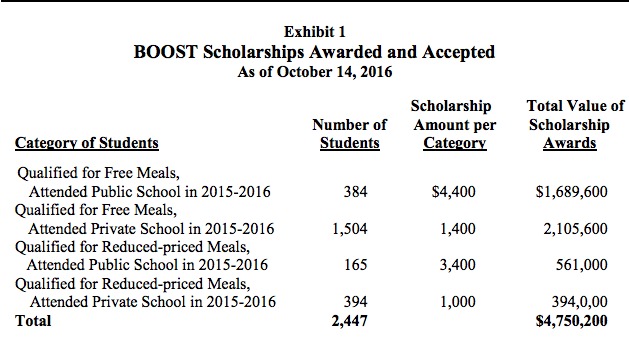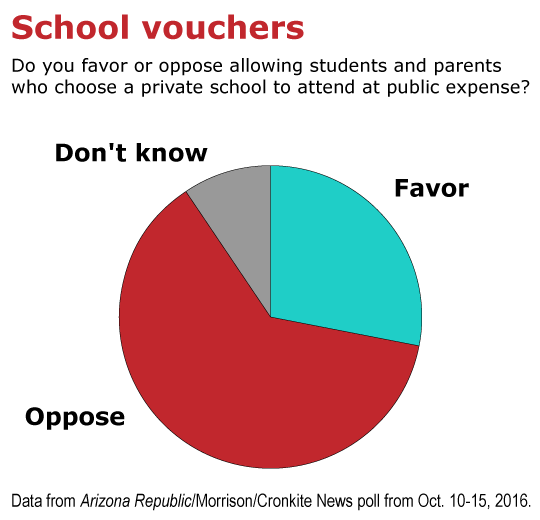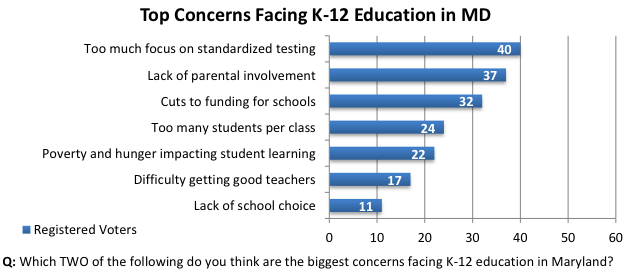Why Larry Hogan Sent Your Taxes to Private Schools
Even though public schools have $2.9 billion in unmet needs
Earlier this week, Gov. Larry Hogan proposed doubling his private school voucher program — known as the BOOST program — over the next three years. The announcement struck many in Annapolis as odd considering the state faces a $400 million budget deficit and has already cut $82 million from higher education and other public services.
According to both the state comptroller and treasurer, the budget deficit is due to a revenue shortfall caused by stagnant growth in Maryland household incomes. During Gov. Hogan’s first year in office, Maryland household median income grew by just 2.4%, compared to 5.2% nationally. Maryland’s relatively stagnant economy was due largely to the Baltimore-Columbia-Towson metropolitan area, which ranked dead last in household income growth among the 25 most populous areas in the nation — an increase of just 1.3%.
So thanks to Gov. Hogan’s weak economic record so far, his administration has largely focused on cuts to public services — including $93 million for public schools. But at the same time, he started a new program that sends scarce taxpayer dollars to expensive private schools. Now he wants to expand it.
Private School Vouchers: A Failed Right-Wing Idea
Private School Vouchers: Taxpayer-funded subsidies awarded to parents to pay for private school tuition, including religious schools.
Republicans have pushed private school vouchers for decades ever since the concept was started by conservative economist Milton Friedman as a way to privatize America’s public schools. As the centerpiece of his education agenda, President-Elect Donald Trump wants to shift $20 billion of funding reserved for low-income students to private school vouchers. As he rolled out his proposal during the presidential campaign, Trump said, “It’s time to break up that monopoly,” in reference to public schools.
While the major aim of these programs is to open the education market to for-profit interests, they have been sold largely as escape paths for low-income children stuck in so-called “failing” schools. But there are two major flaws with that argument: 1. Most recipients of vouchers are students already enrolled in private schools; and 2. When students do move from public schools to private schools using vouchers, their academic achievement actually goes down.
78% of BOOST voucher recipients were already enrolled in private school.
There’s a reason why only private school parents and administrators come to bill hearings and lobby visits to push for voucher programs: there’s no large-scale desire of public school parents to send their kids to private schools. Instead, parents would rather see improvements to their neighborhood public schools. For example, Louisiana offered vouchers to more than half of their students in 2013 and just 2% of eligible parents applied for the program.
With an absence of demand from public school parents, there is ample opportunity for private schools to encourage their parents to apply for these vouchers — subsidizing the school’s operation with taxpayer dollars in the process. According to the Department of Legislative Services, BOOST gave out $4.75 million worth of vouchers to 2,447 students — of which, 1,898 were already enrolled in private school. That’s 78%.

Public education advocates warned the governor that this would happen if he went through with his program because we have seen this happen in other states. The Southern Education Foundation studied a similar program in Georgia and found that private school enrollment increased by only one-third of one percent in the metropolitan counties that included most of the private schools in the scholarship program. Arizona’s program quickly lost public favor after it became clear the program primarily helped students already in private schools.

Study after study shows voucher programs fail to boost the academic achievement of participants — and often make it worse.
Wisconsin Department of Public Instruction report on Milwaukee Program: “Students in Milwaukee’s school choice program performed worse than or about the same as students in Milwaukee Public Schools in math and reading on the latest statewide test, according to results released Tuesday that provided the first apples-to-apples achievement comparison between public and individual voucher schools.”
MIT Study of Louisiana Program: “Attendance at an LSP-eligible private school lowers math scores by 0.4 standard deviations and increases the likelihood of a failing score by 50 percent. Voucher effects for reading, science and social studies are also negative and large. The negative impacts of vouchers are consistent across income groups, geographic areas, and private school characteristics, and are larger for younger children.”
Chalkbeat Education News on Indiana Program: “A new long-term study out of Indianapolis, done by researchers at Notre Dame University, found that students who switched from traditional public schools to Catholic schools actually did worse in math.”
“Our historical understanding of the superior performance of private schools is no longer accurate. Since the nineties, public schools have been under heavy pressure to improve test scores. Private schools were exempt from these accountability requirements. A recent study showed that public schools closed the score gap with private schools.”
— The Brookings Institution
We Need to Focus on Our Public Schools Instead
Gov. Hogan’s first budget proposal would have cut $600 million from public schools over four years if it had been approved. He successfully withheld $93 million from public education despite approval of those allocations by a broad, bipartisan coalition of legislators in the General Assembly. It took $40 million of corporate welfare to get him to agree to filling a $20 million gap in local education funding for next year. These are actions the governor may not own up to, but they are his indisputable record.
All of those actions ignore the fact that Maryland’s public schools have $2.9 billion less than they need — according to independent experts — to get every student to be college or career ready. Every taxpayer dollar that is currently being spent in private schools is a dollar that isn’t being spent in your neighborhood public school, helping to plug that gap in resources our kids need.
That’s why Marylanders are overwhelmingly focused on ways to improve existing public schools rather than have more “school choice.”

The reality of how private school vouchers pull funding away from public schools is especially alarming when you see just how often these programs balloon in cost. Under Vice President-Elect Mike Pence, Indiana’s program swelled to $131 million this year. In July of 2015, the Arizona Republic ran an investigative article with the headline: “Arizona private-school families cash in on state’s tax-credit program; a program that legislative budget staff in 1997 estimated would cost $4.5 million a year now tops $140 million.” Under Gov. Jeb Bush, Florida passed a tax credit voucher program in 2001 with an annual cap of $50 million; by 2015, the cap had grown to $358 million.
Now Gov. Hogan wants to join his Republican governor friends and expand Maryland’s program. In ten years, how expensive do you think he wants his program to be? How are we going to adequately fund our public schools if we keep expanding state funding for private schools?
Private school voucher programs are opposed by 58% of Maryland voters — and that number goes up to 78% when voters learn how that funding could be used in public schools. The vast, vast majority of students served in these programs are already in private school. And for the public school students who do make the switch, their academic achievement goes backwards.
The General Assembly should respond to Gov. Hogan’s proposal by eliminating his tax dollars for private schools program altogether — before it’s too late.

